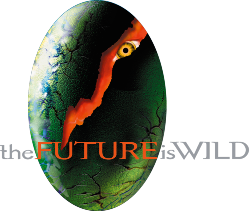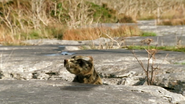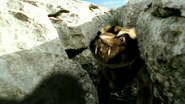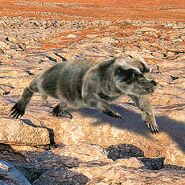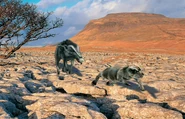| Gryken Temporal range: 5 million AD | |
|---|---|

| |
| Scientific classification | |
| Kingdom: | Animalia |
| Phylum: | Chordata |
| Class: | Mammalia |
| Order: | Carnivora |
| Family: | Mustelidae |
| Gallery | |
| “ | Unfortunately, [this] is also the domain of the scrofas' greatest enemy. Down in a narrow gryke, a slim, agile creature winds from side, to side, following the torturous route of the chasm. It is a gryken, and it is tracking scrofas.
|
” |
The gryken is a predatory mustelid endemic to the limestone plateaux and mountains of the Mediterranean Salt Flat in 5 million AD. A descendant of the pine marten, it is a specialised inhabitant of fissures and crevices in the limestone, called grykes. It uses the grykes for navigation, for ambushing prey, and as a safe retreat.
Evolution[]

The gryken evolved from the pine marten (Martes martes).
The gryken evolved from the Human era pine marten (Martes martes), a common arboreal mustelid which existed throughout Europe. The pine marten was adapted to live and hunt among the branches of the forest canopy, but forests became rare in ice age Europe, and almost absent in the Mediterranean Basin. Mediterranean pine martens were able to rapidly adapt to an entirely terrestrial lifestyle, becoming grykens.[1]
The gryken's prominent fangs have evolved convergently with those of another predatory mustelid of 5 million AD, the sabre-toothed snowstalker.[2]
Description[]
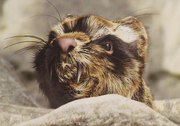
The gryken's facial markings help to camouflage it (A Natural History of the Future).
The gryken stands approximately 20 cm (7 in) tall at the shoulder,[1] and does not exceed 1 m (3 ft) in length.[3] It has a gracile, mongoose-like appearance: its torso is elongated, slender, and sinuous, and it lacks the long tail of its ancestor.[4] Its limbs are long, increasing its cursorial abilities.[1] A thick band of black fur crossing its triangular face camouflages its eyes, and stripes or mottled patterns on its sleek, glossy coat serve the same purpose for its body. Its upper canines are elongated into a pair of dagger-like projecting fangs.[2]
Behaviour[]
Grykens are carnivorous ambush predators which stalk their prey from the safety of the grykes. Their long and gracile bodies allow them to navigate such crevices with ease. Where there is sufficient vegetation growing from the grykes, they will stand on their hind legs to observe their prey from behind cover.[2] Grykens use their long fangs to pierce tough animal hides, and despatch their prey by puncturing its throat and tearing out its windpipe,[2] or by slashing open its abdomen and waiting for it to die.[3] Dead and disabled prey is thrown or dragged into the grykes to be consumed in safety.[2] Grykens will scavenge carrion during harsh periods.[3]
Grykens hold large territories, which, like Human era mustelids, they probably delineate using anal scent glands. Their courtship and reproduction probably also resembles that of the pine marten.[3]
Ecology[]
Grykens live only on the limestone karst plateaux which fringe the Mediterranean Salt Flat and its mountains. These rocky pavements are composed of solid blocks called clints, which are scoured by intersecting fissures, the grykes.[1] Grykens are more common on the upland plateaux than on the edges of the karst, near the salt flat.[2]
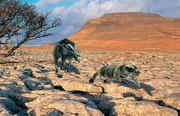
Adult scrofas are too large to be threatened by grykens, which flee from them.
They are the "worst enemies"[2] of scrofas, small pigs which are also endemic to the karst plateaux: juvenile scroflets, which are ambushed when they wander too far from their herds, are the gryken's main prey item. Adult scrofas, particularly the aggressive males, are too large and dangerous for grykens to hunt. They also take smaller animals, such as female cryptiles which visit the karst to lay eggs in the grykes. The eggs themselves are generally laid out of reach from grykens.[1][2]
Appearances[]
In the documentary[]
In "The Vanished Sea," a gryken chases a cryptile which has been laying eggs in a gryke, but the lizard escapes, as does a scroflet which the gryken attacks afterwards, resulting in a scrofa boar charging it. The gryken continues to stalk the scrofa herd, and eventually, successfully kills a scroflet.
List of appearances[]
- The Future Is Wild
- 1x01. Welcome to the Future
- 1x03. The Vanished Sea
- The Future Is Wild: A Natural History of the Future
- The Wild World of the Future
- The Future Is Wild: The Living Book
Gallery[]
In other languages[]
| Language | Name | Translation |
|---|---|---|
| French | Guetteur des failles / Latiaser | "Watcher of the faults" |
| Italian | Dolino | |
| Japanese | Guraiken (グライケン) | Transcription of English name |
| Czech | Gryken | Based on English name |
References[]
- ↑ 1.0 1.1 1.2 1.3 1.4 The Future Is Wild: The Vanished Sea (EP03)
- ↑ 2.0 2.1 2.2 2.3 2.4 2.5 2.6 2.7 Dixon, Dougal & Adams, John (2002) The Future Is Wild: A Natural History of the Future, Firefly Books, ISBN 978-1552977231
- ↑ 3.0 3.1 3.2 3.3 The Future is Wild™ - Future Worlds
- ↑ Dixon, Dougal & Adams, Joanna (2014) The Future Is Wild: The Living Book, The Future is Wild Australia Pty Ltd.
[]
| |||||||||||
